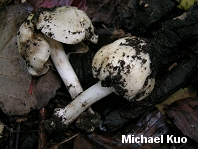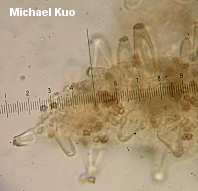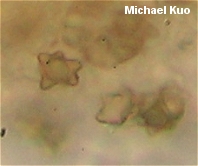| Major Groups > Gilled Mushrooms > Dark-Spored > Inocybe > Inocybe fibrosa |

|
Inocybe fibrosa sensu Kauffman (1918, 1924) [Basidiomycetes > Agaricales > Cortinariaceae > Inocybe . . . ] by Michael Kuo I've identified my collection of Inocybe fibrosa using two sources that are over 80 years old, so don't ask me to testify as an expert witness. Charles Kauffman (1918, 1924) used the European species name Inocybe fibrosa for New York and Michigan collections of a large, white Inocybe that grew in "low, moist, frondose woods" and had a strong odor, funky spores, and prominent pleurocystidia. My collection matches Kauffman's descriptions fairly well--but the European Inocybe fibrosa was described by Saccardo (1887) as growing in "silvis arenosis" ("sandy woods") and more recently by Moser (1978) as growing in "[m]ountain coniferous woods on chalk" and in "meadow woods (with Allium ursinum) etc." In other words, Kauffman's "Inocybe fibrosa" might easily be distinct from the European species, despite parallels in physical features, since the ecosystems in which the organisms evolved are so different. Description: Ecology: Presumably mycorrhizal; growing gregariously in hardwood lowlands (but see comments above); summer and fall; eastern North America. Cap: 4-10 cm; broadly bell-shaped, becoming broadly convex with a central bump; dry; silky; whitish, sometimes developing yellowish stains; the margin often splitting when mature. Gills: Attached to the stem (sometimes by a notch) or nearly free from it; close; whitish, becoming grayish brown and eventually medium brown to cinnamon brown. Stem: 4-8 cm long; up to about 1.5 cm thick; more or less equal, with a slightly swollen base; dry; silky or smooth; whitish, developing yellowish to grayish stains and discolorations. Flesh: Whitish. Odor: Spermatic. Chemical Reactions: KOH on cap surface negative. Spore Print: Dull brown. Microscopic Features: Spores 9-13 x 5-7 µ; "angular-oblong, with obscure scattered tubercles" (Kauffman, 1924; my collection had decidedly nodulose spores). Pleurocystidia up to 90 x 15 µ; cylindric or subfusoid; frequent; thick-walled; sometimes apically encrusted. REFERENCES: (Sowerby, 1809) Gillet, 1874. (Saccardo, 1887; Kauffman, 1918; Kauffman, 1924; Moser, 1978.) Herb. Kuo 09230609. This website contains no information about the edibility or toxicity of mushrooms. |
© MushroomExpert.Com |
|
Cite this page as: Kuo, M. (2007, April). Inocybe fibrosa. Retrieved from the MushroomExpert.Com Web site: http://www.mushroomexpert.com/inocybe_fibrosa.html |


